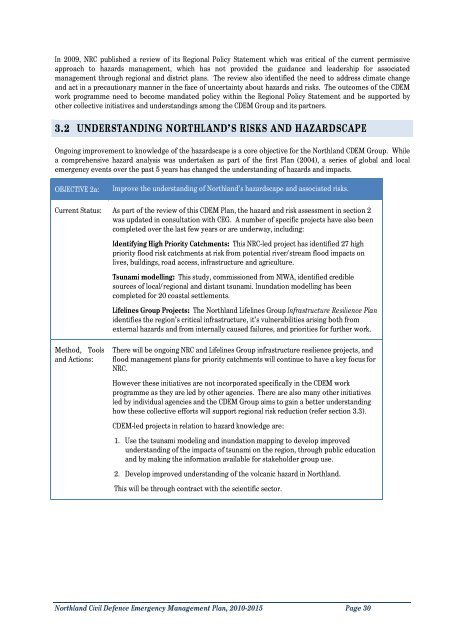Northland Civil Defence Emergency Management Plan, 2010
Northland Civil Defence Emergency Management Plan, 2010
Northland Civil Defence Emergency Management Plan, 2010
- No tags were found...
Create successful ePaper yourself
Turn your PDF publications into a flip-book with our unique Google optimized e-Paper software.
In 2009, NRC published a review of its Regional Policy Statement which was critical of the current permissiveapproach to hazards management, which has not provided the guidance and leadership for associatedmanagement through regional and district plans. The review also identified the need to address climate changeand act in a precautionary manner in the face of uncertainty about hazards and risks. The outcomes of the CDEMwork programme need to become mandated policy within the Regional Policy Statement and be supported byother collective initiatives and understandings among the CDEM Group and its partners.3.2 UNDERSTANDING NORTHLAND’S RISKS AND HAZARDSCAPEOngoing improvement to knowledge of the hazardscape is a core objective for the <strong>Northland</strong> CDEM Group. Whilea comprehensive hazard analysis was undertaken as part of the first <strong>Plan</strong> (2004), a series of global and localemergency events over the past 5 years has changed the understanding of hazards and impacts.OBJECTIVE 2a:Improve the understanding of <strong>Northland</strong>’s hazardscape and associated risks.Current Status: As part of the review of this CDEM <strong>Plan</strong>, the hazard and risk assessment in section 2was updated in consultation with CEG. A number of specific projects have also beencompleted over the last few years or are underway, including:Identifying High Priority Catchments: This NRC-led project has identified 27 highpriority flood risk catchments at risk from potential river/stream flood impacts onlives, buildings, road access, infrastructure and agriculture.Tsunami modelling: This study, commissioned from NIWA, identified crediblesources of local/regional and distant tsunami. Inundation modelling has beencompleted for 20 coastal settlements.Lifelines Group Projects: The <strong>Northland</strong> Lifelines Group Infrastructure Resilience <strong>Plan</strong>identifies the region’s critical infrastructure, it’s vulnerabilities arising both fromexternal hazards and from internally caused failures, and priorities for further work.Method, Toolsand Actions:There will be ongoing NRC and Lifelines Group infrastructure resilience projects, andflood management plans for priority catchments will continue to have a key focus forNRC.However these initiatives are not incorporated specifically in the CDEM workprogramme as they are led by other agencies. There are also many other initiativesled by individual agencies and the CDEM Group aims to gain a better understandinghow these collective efforts will support regional risk reduction (refer section 3.3).CDEM-led projects in relation to hazard knowledge are:1. Use the tsunami modeling and inundation mapping to develop improvedunderstanding of the impacts of tsunami on the region, through public educationand by making the information available for stakeholder group use.2. Develop improved understanding of the volcanic hazard in <strong>Northland</strong>.This will be through contract with the scientific sector.<strong>Northland</strong> <strong>Civil</strong> <strong>Defence</strong> <strong>Emergency</strong> <strong>Management</strong> <strong>Plan</strong>, <strong>2010</strong>-2015 Page 30
















